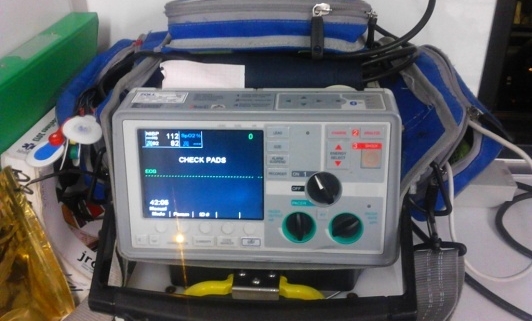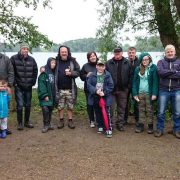Essential Skills – Advanced Life Support
By Rob M AOR
The Rite has many members from different backgrounds and life experiences as well as differing forms of employment. This means we have a wealth of knowledge and practical skills that can only enhance our community and faith. It is with this in mind that Rory OR has started an excellent project on Essential Skills in which members can share and educate on their particular area.
I was kindly asked by Rory to write an article on my professional employment. Being very new to the OR I was only too pleased to but also somewhat daunted by this. What do I write? How do I go about it? And, what can I offer? Rory put my mind at rest and suggested I follow on from his article on basic life support (BLS). As a paramedic, I am regularly engaged in using both BLS and the techniques of advanced life support (ALS) I am trained to use.
I have decided to keep this as an overview and explain things in layman’s terms, or as I like to describe it as ‘normal speak’. I have over 25 years experience in the field and hopefully I can convey some insights, useful information and most importantly, confidence. Confidence in stepping forward if ever presented with a serious situation where a member of our family or of the public seeks medical help. Because the most common conversation I hear post event from people discussing their experiences when administering first aid is, “Did I do the right thing? Did I do enough?”
I can answer that easily without even knowing the circumstances and that is, yes, you did the right thing and you definitely did enough. It can be a huge undertaking for someone to get involved and try and help in a serious situation. This is especially true if no training has been undertaken or it has been years since. As an example, with simple household DIY I take a while to study how to fix a leaking pipe before actually manually getting to work. I need to recheck everything a few times before attempting the work. I have had no training and therefore am very conscious of making a mistake and more worryingly, making things even worse. If someone’s health or life is at risk, the pressure and anxiety is much heightened, of course.
Before I actually outline some of the equipment and procedures we use, I think it worth mentioning that if you feel overwhelmed by the scenario to the point that you cannot physically help, then that is ok. Seriously, that is normal and how you are feeling at that particular moment in time. Simply being with the patient can make a huge difference. If you can keep calm and be supportive to the patient, this can be extremely beneficial. No one wants to be alone when they are scared and sick. Explaining that help is on the way and you will stay with them until the professionals arrive, the importance of this cannot be overemphasized.
I admire anyone who can when called upon, step forward and administer BLS. These skills are easily learnt and can make a difference. As paramedics, BLS is the foundation of everything else we have to offer. Without BLS in a cardiac arrest, there is no chance of survival. With all the fancy equipment, drug therapy and evasive procedures we have to hand, these are useless without good BLS. Members of the public that give BLS prior to our arrival are the patient’s best hope – FULL STOP!
The first part of BLS training is the airway, often referred to as airway management and is the most important part. Simple techniques and movement can be all that is required and can be the difference between life and death. Regarding a cardiac arrest (patient stopped breathing and heart has stopped), airway management is crucial. The rescuer, in giving mouth to mouth to breathe for the patient, has to constantly re-adjust and check the airway to ensure that the procedure is carried out correctly each time it is performed. As ambulance staff, we have equipment that can both minimize this and make it more efficient. Below are some pictures of the equipment at our disposal:
Oropharyngeal Airway (OPA): These are easily inserted in the mouth and ensure the airway is maintained and oxygen reaches the lungs. These are used by trained staff in BLS.
Bag valve mask (BVM): is an excellent piece of equipment in which the face mask is held over the patients mouth and nose with a specific method to create a perfect seal. the bag has is filled with oxygen and is squeezed to inflate lungs. this can be adapted to suit the patient and is less labour intensive than the BLS method.
I-gel: The I-gel is inserted into the airway and rests over the trachea (windpipe). It creates a seal around the area, thus completely protecting the airway and once connected to a BVM or ideally a mechanical breathing apparatus , oxygen can enter directly into the trachea and into the lungs. It can make moving the patient and transportation much easier in the knowledge the airway is taken care of.

Endotracheal Airway (ET tube): is another advanced airway management procedure. The tube passes down the throat, and unlike the I-gel, passes into the trachea and through the vocal cords. Once through the cords it sits just above where the airway splits into two going into each lung. This is the best technique as the tube can be secured in this position and full control over the airway is maintained. it should now be apparent how useful these techniques are but equally how they are built on BLS methods.
It is perhaps worth mentioning also about cardiac monitors and defibrillators. Again this will be a basic overview and not an in depth tutorial. I am hoping that this may demystify the machines as this can be unsettling when visiting patients in hospital.
The heart is an electrical pump. The electrical activity of this organ follows a particular pathway through the heart muscle causing it to contract. With the aid of a cardiac monitor, we observe those patterns. Different heart conditions can affect the patterns and these can be interpreted by (ecg). All the sticky dots with electrical leads attached to them look at the heart at different angles therefore making it easier to pinpoint where some conditions are affecting the heart. Medical staff often make references to ecg changes. This simply means they notice the pattern is not exactly as expected. This is not necessarily serious and treatment is not always required.
When someone is in cardiac arrest, there are two types of very distinctive patterns (Rhythms). These can be reversed by defibrillation. Defibrillation actually stuns the heart, rather than starting it as a lot of people think. The electrical shock momentarily stops the heart in order that its normal rhythm returns and the heart starts to pump normally. There are courses on how to use (AED) and these devices are often found in many large public buildings, supermarkets etc. Once the pads have been applied to the patient, these machines automatically do the interpreting and shocking with verbal commands given at all stages of the procedure.
Along with the above mentioned skills and equipment, as paramedics we also have various medicines available to use too. They are administered intravenously (directly into the veins). These are best described as stimulators and supportive drugs which help stabilize the condition of the heart and patient.
In conclusion, I hope this has been a helpful article and given an insight into just one aspect of my profession. More importantly it has shown how that all the advanced techniques, procedures and methods are all based the foundation of BLS. I hope also that those who may witness such an event will have the confidence to step forward. You will make a difference, no how small your actions may seem. Our heathenry is one of action. Odinism promoted by the Odinic Rite is very much one of action, a doing faith rather than theoretical. The Holy Ones smile on our direct action.
Hail the Gods and Goddesses
Hail the Rite
Hail our folk











Leave a Reply
Want to join the discussion?Feel free to contribute!